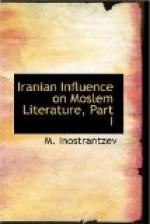Well-known is the importance enjoyed in the beginning of the epoch of the development of the Arabic Musalman literature, by the activities of the Parsi Ibn al Muqaffa.[1] He is famous as the first commentator of the Greek books on logic in Arabic literature, but he is particularly renowned as the efficient supporter of the Persian literary tradition and its translator into the Arabic literature. His rendering of Kalila and Dimma is well-known. It enjoys a prime role in the migration of this collection of stories to the West. Well-known also is his translation of the Persian book of Khoday Nameh,—that is, the official chronicle of the Sasanian times and of the Ain Nameh, the Institutes of the time. We shall have occasion to speak about these books later on. To him also belong the books closely connected with the Sasanian epoch, namely, the Book of Mazdak the Book of Taj to which we shall refer further on. It is interesting that he is also the reputed author of two books on Adab, perhaps among the most ancient ones in Arabic literature.[2] One of these books called the Smaller was probably contained in the other which is called the Larger and has the purely Persian title of Mah farra Jushnas. (This is how the title is to be read according to Hoffmann and Justi).[3] Since the interest of Muqaffa was concentrated in the province of Persian culture it is indisputable that his activity was not confined in this direction to one book and the contents of the book have vestiges in a high degree of dependence on Persian motifs. This is proved by a variety of circumstances. We have descended to us his book called Al Yatima, a tract on that aspect of morals which was especially diffused in the Sasanian epoch and was devoted to politics and in form represented the species of writings called Furstenspiegel.[4] A tradition of this kind of literature for long continued to live in the Musalman writers and the typical representative of the species seems to be the famous Siyasat Nameh, of Nizam-ulmulk, the Saljuk Wazir. On some occasions it directly serves as a source for the internal history of the Sasanian domination. It bears particularly on didactic literature though it has been as yet very ill studied from the comparative standpoint. The Sasanian influence is perfectly obvious. Some portions of Al Yatima of Ibn Muqaffa may be parallelled to corresponding remnants from Pahlavi literature in the Kabus Nameh and the Siasat Nameh.[5] We know further that books under the title of Persian Adab were spread among those who sympathised with Mazdaism and Manichism in the circle of Moslem society.[6] These books by their character were comparable to books on Mazdak but also to Kalila wa Dimna.
[Footnote 1: Fihrist, 118, 18-29, and Ibn al Qifti’s Tarkh al hukama edited by Lippert, page 220, 1-10.]
[Footnote 2: Brockelmann, On the rhetorical writings of Ibn all Mukaffa, Z.D.M.G. 53, 231-32.]




